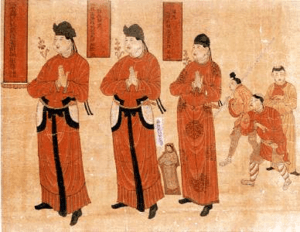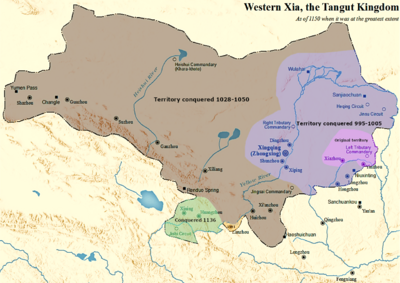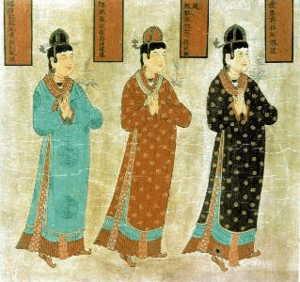Tangut people facts for kids
| 𗼎𗾧 | |
|---|---|

Tangut officials
|
|
| Regions with significant populations | |
| Western Xia | |
| Languages | |
| Tangut | |
| Religion | |
| Buddhism, Shamanism, Animism |
The Tangut people were an ancient group from Asia. They created and lived in the Western Xia kingdom. They spoke the Tangut language, which is now extinct. They also had their own special writing system called the Tangut script.
The Tanguts first lived under another group called the Tuyuhun. Later, they became part of the Tang dynasty in China. After the Tang dynasty ended, the Tanguts built their own powerful kingdom, the Western Xia. Sadly, the Mongol Empire destroyed the Western Xia kingdom in 1227. Most of their written records and buildings were lost. Today, the Tangut language and its unique writing are gone. Only small pieces of their literature remain.
Contents
The Tangut Language
The Tangut language is part of the Sino-Tibetan language family. This family includes languages like Chinese and Tibetan. Like many languages in this family, Tangut was a tonal language. This means the meaning of a word could change based on the pitch of your voice. Most Tangut words were also very short, often just one syllable.
For a long time, people wondered if Tangut was related to the Qiang or Yi languages. Chinese experts often thought the Tanguts were connected to the Qiang people. The name "Qiang" was used for many different groups living on the western edge of China. The name "Tangut" first appeared in old writings from 735 AD. In their own language, the Tanguts called themselves Mi-niah. This name is still linked to places in China today, like the Min River.
How the Tanguts Looked
A traveler named William of Rubruck visited the Mongol Empire in the 1200s. He wrote about the Tangut people. He said they were brave and had some tall, dark-skinned men. This was different from the Uyghurs, who he described as being "of medium size, like us."
The Tangut people I saw were tall but swarthy. The Iugurs are of medium build like our own people.
Where the Tanguts Came From
The early Tanguts lived in the mountains and plains of what is now southeast Qinghai and northwest Sichuan in China. This area is part of the Tibetan plateau. At one point, their leader, Tuoba Chici, joined the Tang Chinese rule. He was given the Chinese family name "Li."
In the early 700s, the powerful Tibetan Empire forced the Tanguts to move north. They settled in the eastern Ordos region. By the time of the An Lushan Rebellion (755–763), the Tanguts were a strong local power. They controlled areas that are now eastern Gansu, Ningxia, and northern Shaanxi.
History of the Tangut Kingdom

In 881, the Tanguts helped the Tang Chinese government stop a big rebellion. As a reward, the Tang government gave the Tangut general Li Sigong control over three important areas. These areas became his family's to rule forever.
After the Tang dynasty fell, many warlords started their own states. The Tanguts expanded their land towards their old homes in the southwest. In 1002, they took over Ling Prefecture and made it their first capital. By 1036, they had conquered more land, even pushing into Tibetan areas. The Tangut kingdom, called Western Xia, was officially started in 1038.
The Tanguts had been part of Tang China for 200 years. Because of this, they adopted many Chinese customs. But they also kept their own traditions. We know this because many Tangut writings survived.
The founder of Western Xia, Li Deming, had a son named Li Yuanhao. When Li Yuanhao became emperor, he wanted to make the Tangut kingdom unique. He wanted it to be different from the Chinese-led Song kingdom. So, he worked to build a strong Tangut identity. He ordered the creation of the official Tangut script. He also made laws that supported old Tangut customs. For example, one law said people had to wear traditional Tangut clothes. Another law required men to wear their hair short or shaved, unlike the Chinese custom of long hair. He even changed his royal family name from the Chinese "Li" to a Tangut name, Weiming. He made Xingqing (modern Yinchuan) his capital city.
In the 1200s, Genghis Khan united the Mongol tribes. He led his armies in six attacks against the Western Xia kingdom over 22 years. During the last attacks, Genghis Khan died in Western Xia territory. Some say he died from an illness, while others believe he was wounded in battle.
In 1227, the Mongols took over the capital of Western Xia. They destroyed most of its buildings and writings, burning everything except one monastery. The last emperor was killed, and many thousands of people were massacred. However, many Tangut families joined the Mongol Empire. Some Tanguts even led Mongol armies in conquering China. Later, under the Yuan dynasty (1271–1368), Tangut soldiers joined the Mongol army. Small groups of Tangut people were still found in China as late as the Ming dynasty (1368–1644). Some Tanguts moved to western Sichuan, northern Tibet, and possibly even northeast India. They kept their language until at least the 1500s.
Tangut Culture
Tangut society had two main groups: the "Red Faced" and the "Black Headed." The Red Faced Tanguts were common people. The Black Headed Tanguts were the leaders and priests.
Even though Buddhism was very popular, many Tangut herdsmen still practiced a type of shamanism called Root West. The black hats worn by Root West shamans gave the Black Headed group its name. According to Tangut stories, the ancestor of the Black Headed Tanguts was a white crane from the sky. The ancestor of the Red Faced Tanguts was a monkey. Tangut kings were called Wuzu.
In the Tangut language, their kingdom was called "Great State of White and Lofty." The Chinese often called it "Great Xia" or "Xia State." Later, it became known as "Western Xia." The Mongols called the Tangut kingdom "Qashi."
Tangut Religion
The Tanguts were mostly Buddhists. Their Buddhism mixed ideas from both Tibetan and Chinese traditions. The entire collection of Chinese Buddhist writings was translated into the Tangut language. This huge project took 50 years and was finished around 1090 AD. It filled about 3,700 books!
Some Buddhist texts that people thought were originally Tangut turned out to be translations from the Khitan language. New discoveries show that Tangut Buddhism was more influenced by local cultures in North China than by pure Tibetan or Chinese ideas.
Many Tangut Buddhist groups, like the "Imperial Preceptor," continued to exist even after the Tangut kingdom fell. They were still found during the Yuan dynasty. A key place for Tangut Buddhism was Mount Wutai. Both Huayan Buddhism and Chinese Esoteric Buddhism grew there.
The Tangut state had strict rules about teaching religious beliefs. New teachers from Tibet or India had to get approval from local leaders. The teachings and methods were carefully watched to make sure people understood them correctly. Fortune-tellers or fake religious leaders were punished right away. The Tangut state also strictly forbade religious teachers from taking money for their lessons. They believed this went against Buddhist rules.
Even though the government didn't support just one type of Buddhism, it protected all religious sites and objects in the country.
Like in China, becoming a Buddhist monk needed government permission. Anyone who became a monk without this permission faced serious punishment. Interestingly, women also played a role in Tangut religious practices. They could become nuns, but only if they were widows or unmarried virgins.
After the Western Xia kingdom fell, many Tangut people moved to Tibet. This led to the adoption of the Pehar deity into Tibetan Buddhism. Pehar eventually became a very important state oracle in Tibet.
Images for kids
-
Statue head of a Buddhist arhat, Western Xia dynasty, from Hongfo Pagoda, Helan County, Ningxia
See also
- Tangut script
- Tangut language
- List of Tangut books
- Dingnan Jiedushi, an independent Tangut kingdom
- Western Xia (also called the Tangut Empire)








